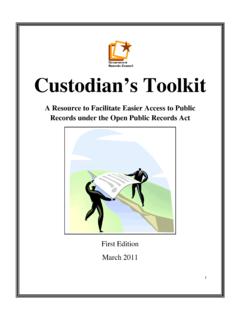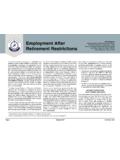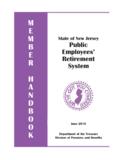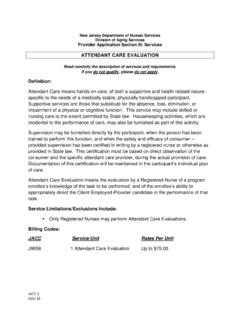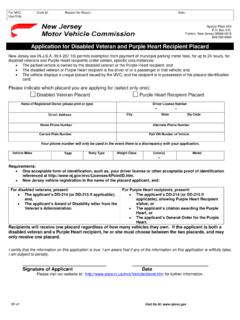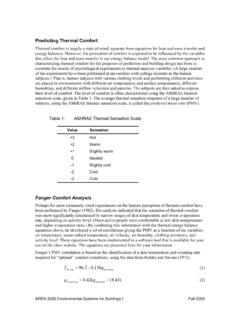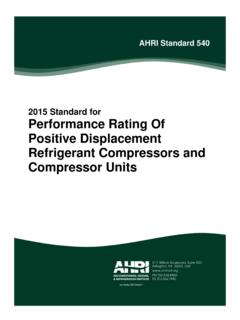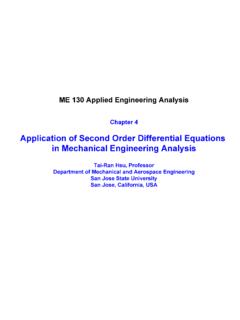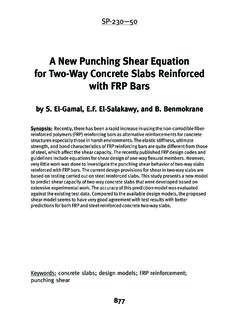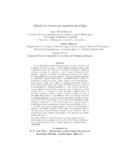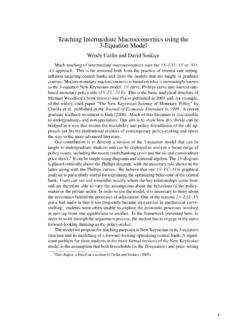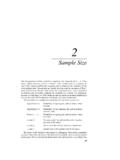Transcription of Soil-Water Partition Equation Modification - New …
1 GUIDANCE DOCUMENT DEVELOPMENT OF IMPACT TO GROUND water soil REMEDIATION STANDARDS USING THE Soil-Water Partition Equation Version November 2013 New Jersey Department of Environmental Protection Trenton, New Jersey Table of Contents I. Introduction .. 1 II. equations for Calculating the soil Remediation Standards .. 2 III. Soil-Water Partition Equation Assumptions .. 3 IV. Practical Quantitation Levels (PQLs) .. 3 V. soil Saturation Limit (Csat) .. 3 VI. Developing an Impact to Ground water soil Remediation 4 A.
2 Sites with No Site-Specific Information .. 4 B. Sites with Site-Specific Information .. 9 VII. Determination of Site-Specific Parameters .. 10 A. Fraction Organic Carbon - foc .. 10 B. Soil-Water Partition Coefficient - Kd .. 11 C. Dilution-Attenuation Factor - DAF .. 11 D. Ionizable Phenol Koc Values for soil pH .. 11 VIII. Submission Requirements .. 14 APPENDIX A Sensitivity of the Soil-Water Partition Equation to Modification of Component Parameters .. 15 APPENDIX B Determining Organic Carbon Content of soil .
3 22 References .. 23 1 I. Introduction This guidance describes the use of the Soil-Water Partition Equation to develop Impact to Ground water soil Remediation Standards. Modified versions of the USEPA soil Screening Level (SSL) Soil-Water Partition equations (USEPA, 1996b, equations 22 and 24) may be used to calculate default Impact to Ground water soil Screening Levels (IGWSSL) or site-specific (alternative) Impact to Ground water soil Remediation Standards (IGWSRS). The Department expanded these equations to separate the target leachate concentration discussed in the USEPA SSL guidance document into its component parts.
4 The target leachate concentration is the product of the health-based ground water criterion (Cgw) and the dilution-attenuation factor (DAF). This Modification allows the Department s health-based Ground water Quality Criterion to be directly entered as an input parameter. The equations for calculating IGWSSL and site-specific IGWSRS are provided in equations 1a and 1b below. The Soil-Water Partition Equation back-calculates a concentration in soil from an acceptable ground water concentration. The Department has provided a table of default Impact to Ground water (IGW) soil screening levels (Table 1) considering the health based Class II-A ground water quality criteria using default site conditions and assumptions.
5 The screening levels provided in Table 1 are appropriate for use at sites where no site-specific data are available. When site-specific information is available, it may be used to calculate alternative impact to ground water soil remediation standards as described in Section VI below. This option will be most useful in the following situations: 1) When a site-specific DAF is higher than the default value, 2) For organic contaminants, when the site-specific soil organic content is higher than the default value, 3) When the Synthetic Precipitation Leaching Procedure (SPLP) is used to determine a site-specific Soil-Water Partition coefficient (Kd) for organic or inorganic contaminants.
6 In this case, the Partition Equation is implemented using the Synthetic Precipitation Leaching Procedure guidance and spreadsheet. For metals and inorganic contaminants, the use of the SPLP procedure to determine a site-specific Kd value is a primary mechanism for site-specifically adjusting the Soil-Water Partition Equation remediation standard. Since site-specific organic carbon contents are only used in conjunction with Koc values for organic contaminants, this leaves only the DAF and Kd parameters that may be adjusted.
7 Since adjustment of the DAF parameter requires information from a ground water investigation, the Kd value from the SPLP test is often the easiest information to obtain. The particular species of these contaminants, as well as the soil pH, greatly influence their adsorptive capacity, or Kd value. The default screening criteria assume mobile species of these contaminants are present since the actual species are unknown. The SPLP test determines the Kd value for the actual species on site and frequently results in higher remediation standards than the default soil screening levels.
8 2 The SPLP procedure is also useful for organic contaminants (particularly semivolatile organic contaminants) because the resulting Kd value may reflect the effect of age of the discharge and the effect of soil parameters other than organic carbon. This will often increase the remediation standard relative to the default value. For Class I and III ground water , ground water quality criteria must be developed by the Department on a site-specific basis. IGW soil remediation standards are then back calculated from ground water criteria using the Soil-Water Partition Equation .
9 In 2012, the Department established a Committee to review and update the guidance for developing site-specific impact to groundwater soil remediation standards. The Committee included Stakeholders and NJDEP staff. This Guidance represents the work of the Committee and it supersedes any previous Department guidance issued on this topic. The following people were on the Committee that prepared this document: Dr. Swati Toppin, Chair NJDEP George Blyskun NJDEP Ann Charles NJDEP Dr. Barry Frasco NJDEP MaryAnne Kuserk NJDEP Dr.
10 Paul Sanders NJDEP Matthew Turner NJDEP Michael Gonshor Roux Associates, Inc. Stephen Posten AMEC Environment and Infrastructure II. equations for Calculating the soil Remediation Standards For organic contaminants: For inorganic contaminants (and organic contaminants with SPLP-determined Kd value): DAFHfKCIGWSRS bawococgw')( Equation 1a Equation 1b DAFHKCIGWSRS bawdgw')(3 IGWSRS = Impact-to-ground water soil remediation standard (mg/kg) Cgw = Ground water Quality Criterion (mg/L) foc = organic carbon content of soil (kg/kg) Koc= soil organic carbon- water Partition coefficient (L/kg) Kd = Soil-Water Partition coefficient (L/kg) w = water -filled soil porosity (Lwater/Lsoil) a = air-filled soil porosity (Lair/Lsoil) H = Henry s law constant (dimensionless) b = dry soil bulk density (kg/L)
